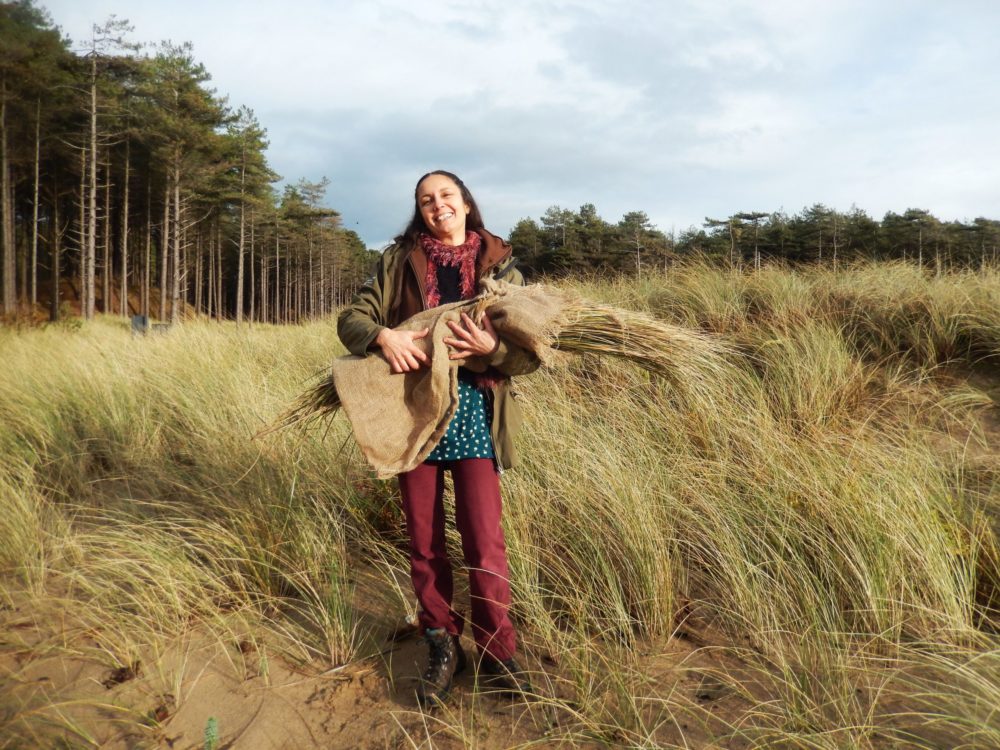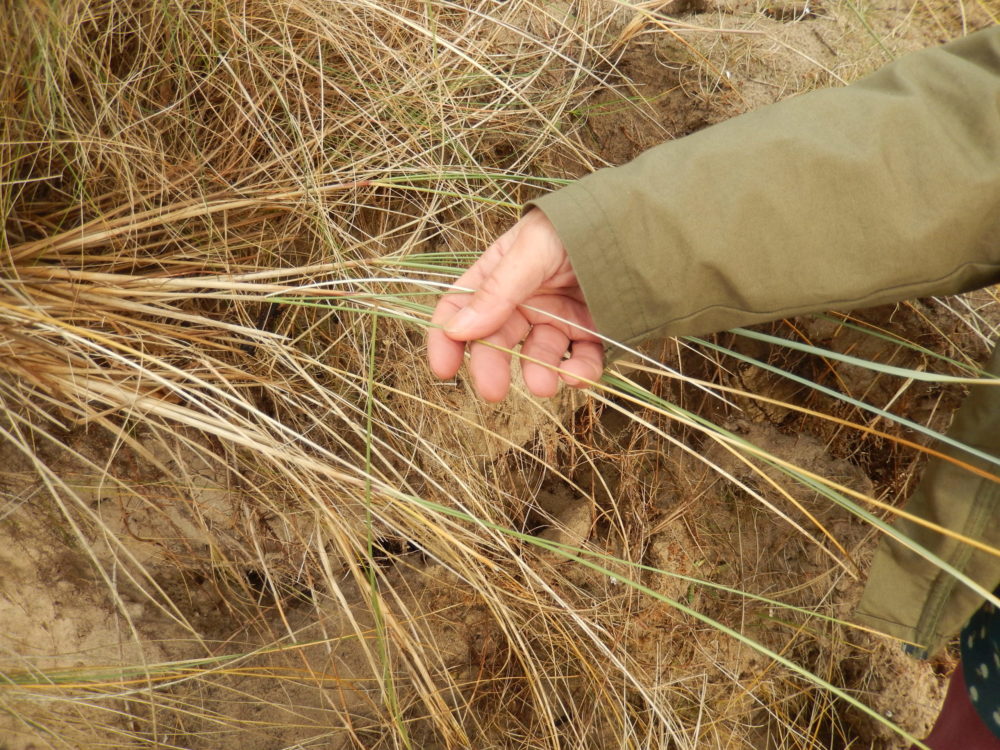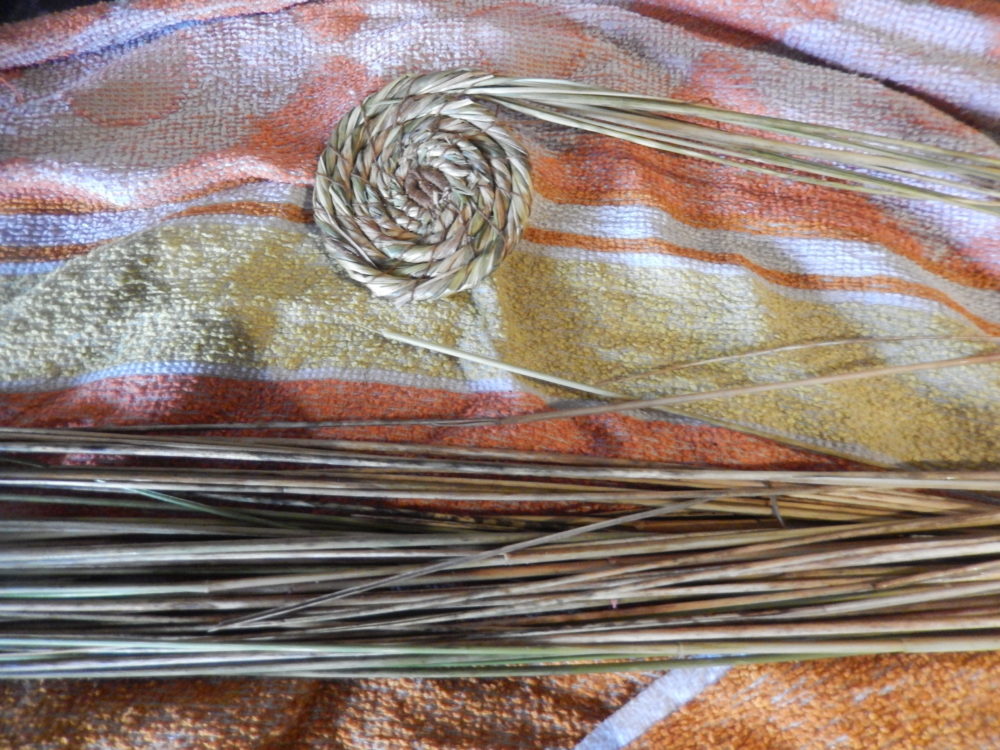Marram; Moresg part two: Melissa and the Weaving Group; Niwbwrch

Julie Brominicks
The protections that Freya had mentioned, to prevent the overharvesting of marram, were put in place in the 16th century at Niwbwrch, Ynys Môn (Anglesey) which was once home to a thriving marram-weaving industry.
Interest piqued, I decide to visit Melissa Dhillon. We’ve been friends since our raving days back in the nineties. Since moving to Niwbwrch with her young family some fifteen years ago, Melissa has learned Cymraeg and basket-making and teaches outdoor skills. It’s no surprise to hear she’s involved in a marram-grass project.
‘When we moved here from Shropshire and the kids were young’ says Melissa, ‘the head teacher at the time spoke with real pride about the local culture and heritage. But we realised that kids now don’t know about it.’
Eryri
It’s a bright November day and we are walking through the dunes overlooking Ynys Llanddwyn, backdropped by snow-clad Eryri across Y Fenai (The Menai). Melissa explains that although there is information locally about the marram-grass heritage, with no one weaving it, the cultural memory was fading.
‘We’d been talking for years about running school sessions. The project is to highlight history and teach the kids simple weaving techniques. We began with things that were easily weave-able like rush and even Corsican pine needles when they’ve been soaked. So not marram to start with because it’s spiky. It’s quite hard on your hands actually.’
Eventually Melissa’s group got permission from Natural Resources Wales (NRW) to harvest marram grass in September 2024, because the Niwbwrch dunes are signed up to a project called Sands of Life which aims to restore dune ecology by (like in New Zealand) bashing through the solid marram-woven walls of sand to allow the dunes to become mobile once more.
But unlike in New Zealand where marram is the main villain, here the factors preventing the dunes from being fluid are post-war forestry plantations holding them in check and lack of appropriate grazing.
As a result the excavators are coming to re-de-stabilize the dunes; and remove some of the trees.

Melissa showed me the dune from which her group had hand-harvested marram the previous day but their impact was so minimal she couldn’t be absolutely sure which dune it was. ‘Roedd diwrnod braf ddoe, yn nghasglu moresg ar gyfer y gwaith efo’r ysgolion lleol’ (It was a lovely day collecting marram for use with local schools) she says.
Among the harvesters were Ffiona and her daughter Sara whose family have lived in the village for years.
‘Ffiona’s gran was Enid Mummery who was the last known marram weaver – until recently! Sara’s father’s gran was also a marram weaver and her daughter Teleri is one of the school children involved in the project’.
Niwbwrch women used to harvest grass with billhooks in the summer and store it to work on over winter, soaking it before weaving.

‘We brought secateurs because a big part of all weaving is sorting it there and then because otherwise when it’s all dried out and no longer green you can’t tell which are the bits you want. But actually in the past they would have used billhooks.
“We know they would have made a diagonal cut at the base of the grass into the root. But harvesting like that is not as selective. Because the best bit to use for weaving is this bit here;’ Melissa shows me the new green growth among the older grass that has already turned yellow.
Guessing game
Melissa says despite all the archive material, weaving marram with no one to teach you is a bit of a guessing game. ‘They would have plaited eleven strands together and then the plaits were sewn together to make mats. But it’s a bit of a learning process as to which part you use.’
Like me, Melissa has been pondering to what extent marram harvesting is so damaging that it resulted in a ban.
For this project it doesn’t matter because NRW is removing the grass anyway.
‘You’d think it would be like coppicing’ she says, ‘and it would grow back. But we don’t know why they cut so close into the root. We wondered whether the cut might stimulate longer grass growth. Or maybe they cut into the roots because then it’s easier to stand up the bundles to dry.’
Presumably, the extent of damage caused by marram harvesting depends on which parts of the plant were taken as well as, of course, the quantity. Melissa and her colleagues are currently using only the pliable grass to make elegant baskets. ‘They used to make fine baskets like these in the past. But mostly the villagers were making purely functional things like mats and ropes and thatch so we wondered whether they might not have been so selective and used more of the plant.’

‘Do you know about Haf Bach Mari Pant?’ asks Melissa as we leave the dunes. ‘An Indian summer in Welsh is generally called Haf Bach Mihangel (Mihangel’s Little Summer). But in Niwbwrch it’s called Haf Bach Mari Pant because Mari Pant preferred to harvest her marram grass in September instead of August.’
Melissa’s Dad hails from India, so I find this linguistic symmetry particularly pleasing. On our way to the bus-stop Melissa shows me the house where Mari Pant lived. It strikes me that my Telford-born friend has put down roots here. ‘I do sometimes think it might be nice to live in Morocco, where it’s warm and things grow so easily…’ she says. ‘But I think yes, I possibly have. For now anyway.’
References
Griffiths, Miriam, ‘The Marram Weavers of Newborough; An Ancient Anglesey Craft’, (Magma 1997)
Social Histories, Llyn Parc Mawr https://www.llynparcmawr.org/social-histories/
The Marram Grass Heritage display in the Prichard Jones Institute, Niwbwrch
Support our Nation today
For the price of a cup of coffee a month you can help us create an independent, not-for-profit, national news service for the people of Wales, by the people of Wales.





the grass basket is just devine, what a gorgous piece of art & design